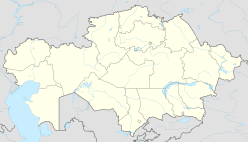Zhamanshin_Crater
Zhamanshin crater
Kazakh meteorite crater
Zhamanshin (Kazakh: Жаман шың, romanized: Jaman şıñ) is a meteorite crater in Kazakhstan. It is 14 kilometres (8.7 mi) in diameter and the age is estimated to be 900,000 ± 100,000 years (Pleistocene). The crater is exposed at the surface.[1]
You can help expand this article with text translated from the corresponding article in Russian. (October 2011) Click [show] for important translation instructions.
|

